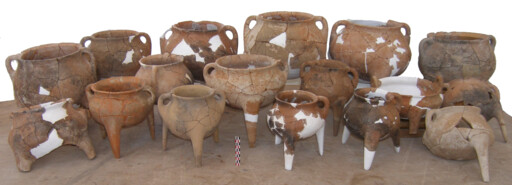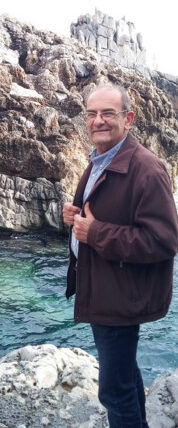


Archaeology sparks new cross-civilizational dialogue

Artifacts discovered at the site of Kanakyia, Salamis Photo: COURTESY OF YANNOS G. LOLOS

Lolos states that shipwrecks hold potential for understanding early seafaring, trade, and cultural interactions, and therefore need urgent research and preservation. Photo: COURTESY OF YANNOS G. LOLOS
Yannos G. Lolos, emeritus professor of Prehistoric Archaeology at the University of Ioannina, is the first scholar in Greece to introduce a university course on “Prehistoric Maritime Archaeology.” Having visited China multiple times, he holds deep respect for Chinese culture. In a recent interview with CSST, Professor Lolos remarked that contemporary archaeology is no longer an isolated discipline, but rather a dialogue that spans time, disciplines, and civilizations. He emphasized that archaeologists should serve as comprehensive interpreters of history, reconstructing the continuity of human experience. He sees great potential in comparative studies between Chinese and Greek civilizations and firmly believes that in today’s interconnected world, international collaboration will inject new vitality and meaning into archaeological research.
Archaeologists as comprehensive interpreters of history
CSST: The field of archaeology has evolved considerably over the years. How have changes in archaeological theory and methodology influenced your own research? Are there any emerging trends in the field that you find particularly promising?
Lolos: In recent decades, archaeological research has undergone a remarkable transformation, largely driven by advancements in technology and the increasing integration of interdisciplinary approaches. These developments have significantly shaped my own research, particularly in terms of how we analyze and interpret material evidence. The use of archaeometric techniques—drawing from fields such as physics, chemistry, and geology—has enabled us to extract new layers of information from ancient artifacts and sites, deepening our understanding of the past.
Equally promising is the growing use of digital tools to engage the wider public, especially younger generations. The application of virtual reality (VR) and augmented reality (AR) technologies in site presentation and education is revolutionizing how people experience archaeology. These immersive methods help bring ancient worlds to life in ways that traditional displays cannot.
Another exciting trend is the global rise of underwater archaeology. Countries like China, the US, and France have made impressive strides in deep-sea exploration, opening up a new chapter in the field. This largely expands the geographical and thematic horizons of archaeological research.
CSST: Archaeological discoveries reveal the extent of cultural interaction between ancient societies. In your view, how did cultural exchange—through trade, migration, or warfare—contribute to the shaping of Greek civilization in prehistoric and early historical periods?
Lolos: The shaping of Greek civilization in late prehistoric and early historical periods was profoundly influenced by cultural exchanges across the broader Eastern Mediterranean world. From as early as 3000 BCE, we have documented evidence of dynamic interaction among the four major cultural zones of the Early Bronze Age (i.e. the 3rd millennium BCE) in the wider Aegean area: Crete, the Cyclades, the Greek mainland, and the western coast of Anatolia. These regions were actively engaged in the circulation of goods, raw materials, and, perhaps most importantly, ideas—ranging from technological innovations to religious concepts and social structures.
As people moved, traded, and sometimes even clashed, they came to understand each other better. These interactions laid the groundwork for richer, more complex societies on all sides, resulting in the emergence of palatial societies in the 2nd millennium BCE.
I also want to stress that as regards the interpretation and reconstruction of ancient societies, the archaeologist’s role is crucial. In my view, our stance in relation to the use of theoretical models should be all-inclusive, multi-dimensional, and not dogmatic. In our interpretations, we ought to follow an essentially contextual, historical, and humanistic approach, directed against trends of fragmentation, over-specialization, and simplification.
CSST: As one of the most active archaeologists in the field of underwater archaeology in Greece, how did you first become involved in this area of research?
Lolos: My involvement in underwater archaeology began in earnest when I joined the Hellenic Institute of Marine Archaeology (HIMA) in 1990. Over the years, this affiliation became central to my professional life—I served as HIMA’s President for 22 years, from 2000 to 2022.
In the early 1990s, I played a substantial role as one of the chief investigators in two of HIMA’s most significant underwater excavations. One was the Early Bronze Age shipwreck off the coast of Dokos, dating to around 2200 BCE, considered one of the oldest known shipwrecks in the world. The other was a Cypro-Mycenaean wreck, dating to approximately 1200 BCE, discovered at Point Iria in the Argolis. These excavations were pioneering at the time and opened new windows into the maritime networks of the prehistoric Aegean.
Beyond these early projects, my long-standing fieldwork has focused on the broader Saronic-Argolic Gulf region, especially the island of Salamis, which has remained for me a central area for both terrestrial and underwater archaeological research for over three decades. My early career also included long-sustained work at Pylos in Messenia, and more recently, I have extended my research to North Ithaca. All these experiences have shaped my enduring interest in how the sea—as a conduit of contact, exchange, and conflict—influenced the development of ancient Greek civilization.
Multiple challenges to archaeological sites
CSST: Given your extensive experience with both terrestrial and underwater archaeology, particularly in Salamis, what do you consider to be the most pressing challenges today in terms of excavation, preservation, and site accessibility?
Lolos: Beyond keeping pace with evolving excavation methodologies, I believe archaeologists today face a range of urgent challenges, both on land and under the sea.
First, we must address the intensification of archaeological survey work, particularly in coastal and inland areas where landscapes are changing rapidly. These transformations, often driven by urban expansion, tourism, or agriculture, can compromise our ability to locate, study, and preserve significant remains before they are lost.
Second, climate change poses a severe threat to many already excavated sites and standing monuments. Rising temperatures, extreme weather, flooding and changing humidity levels can accelerate decay, especially in exposed coastal and island regions. Ensuring both preservation and accessibility in these conditions is a growing concern.
Third, for underwater archaeology, one of the greatest challenges is the long-distance protection and monitoring of submerged sites—such as shipwrecks—which are vulnerable to looting, erosion, and environmental degradation. Advances in digital technology may help us monitor these sites more effectively in the future, but it remains a complex issue.
Comparative studies in language evolution
CSST: Foreign academic institutions, such as the American, British, and German schools, have long been influential in the development of Greek archaeology. In your opinion, what role does international collaboration play in advancing archaeological research in Greece?
Lolos: There is no doubt that the foreign academic and scholarly institutions based in Athens, which have been active since the late 19th century, have played a pivotal role in the shaping and advancement of Greek archaeology, both in terms of fieldwork and academic research. Their long-standing presence and sustained engagement have fostered a tradition of methodological excellence, technical innovation, and scholarly exchange that has left a lasting mark on the discipline.
These institutions have not only undertaken independent excavation and survey projects in various parts of Greece, always in accordance with Greek legislation and under the supervision of the Ministry of Culture, but they have also increasingly collaborated with local Ephorates of Antiquities, Greek universities, and national research centers. This kind of institutional cooperation has become particularly productive in recent decades, bringing together different research traditions, perspectives, and expertise. Such synergies enrich the study of Greek antiquity by combining international experience with local knowledge, while also enabling the implementation of cutting-edge technologies in archaeological documentation and conservation.
CSST: With the establishment of the Chinese School of Classical Studies at Athens (CSCSA), what are your expectations for its contribution to the well-established academic landscape of Greek archaeology?
Lolos: The recent founding of the Chinese School of Classical Studies at Athens is a very welcome addition to a total of 19 foreign schools, which are active in Greece today. The field is certainly open for both senior and younger Chinese scholars to pursue their specialized study and autonomous or collaborative research work on the Mainland or the Islands and eventually make their own original contribution.
Personally, I can point to previous successful collaborations as evidence of the potential for future contributions. For instance, from 2017 to 2019, the University of Ioannina Salamis Excavation organized a productive collaboration with the Department of Archaeology and Museology at Peking University, which involved the active participation of six postgraduate and graduate students from that department in our systematic excavation at the Mycenaean capital of Salamis, at the site of Kanakia. This partnership allowed Chinese students to gain hands-on experience and deepened their engagement with Greek archaeological practices. Additionally, in 2019, I had the honor of organizing an intensive study visit to Beijing for 30 students from our department, which further fostered cross-cultural academic exchanges.
Unfortunately, these collaborative efforts were disrupted by the COVID-19 pandemic, but the potential for future cooperation is significant. I believe that the CSCSA will foster even deeper academic exchanges and research partnerships.
CSST: Given the deep historical roots of both Greek and Chinese civilizations, what are your thoughts on the potential for comparative studies? Are there particular themes or approaches you would recommend?
Lolos: Greek and Chinese civilizations, both with over 3,500 years of continuous written language evolution, offer a unique foundation for comparative studies. They show an early peak around the same time, from the 16th to the 11th centuries BCE, and share abundant archaeological and documentary evidence, such as the clay tablets with the Mycenaean Linear B script and the inscribed Shang Dynasty oracle bones.
A comparative study will foster deeper appreciation of the achievements of these two ancient cultures. We could explore themes such as social structures, governance, and material culture. For instance, the Mycenaean palatial system and the early Chinese state offer interesting contrasts in political organization. Similarly, both civilizations have produced remarkable art and ritual objects, which could be explored in parallel to understand their cultural priorities.
Editor:Yu Hui
Copyright©2023 CSSN All Rights Reserved